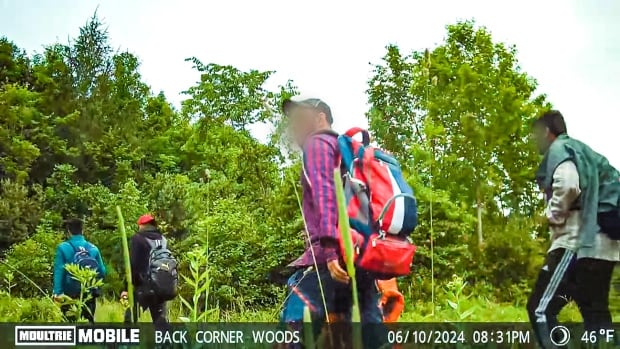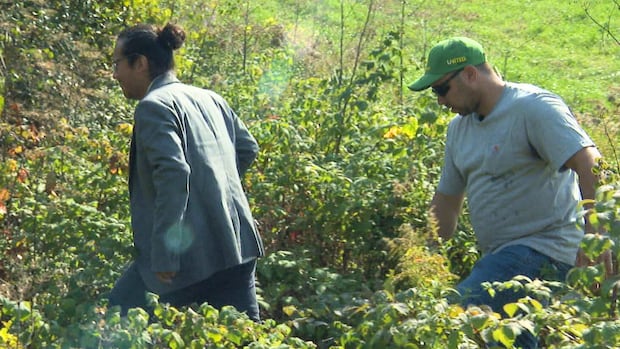The outline of a liquor bottle is carved into boards just beneath the tip of the roof on one side of Chris Oliver’s barn, which sits a few feet away from the Canadian border which runs along the northern edge of his farm near Fort Covington, N.Y.
The outline echoes another age along these borderlands when runners moved contraband liquor from Canada south across this stretch of land between Quebec and New York state during prohibition.
Now a different type of traffic is moving through Oliver’s farm: people.
Over the past several months a growing tide of men, women and sometimes children have used Oliver’s farm as a transit point on clandestine foot journeys from Canada to the U.S.
They’ve all passed on front of his home, where he lives with his wife and three children, and it’s all captured on his trail cameras.
In the week leading up to this past Labour Day, Oliver’s cameras recorded 48 people crossing near his doorstep.
“And that’s just one camera, in one area, so it’s hard to say how many actually did walk by,” said Oliver, 32.
Dozens of migrants are seen crossing into New York State from Quebec on security cameras set up by a local farmer, Chris Oliver. CBC blurred the migrants’ faces in the footage as CBC was not able to speak with them to verify their stories.
Oliver’s farm sits just east of the Dundee, Que., border crossing around 170 kilometres southwest of Montreal. It is part of an area that runs roughly 100 kilometres from Cornwall, Ont., and east to Champlain, N.Y., that sees some of the highest rates of U.S.-bound illegal crossings anywhere along the Canada-U.S. border, according to court records and U.S. Customs and Border Protection data.
The U.S. Border Patrol intercepted just over 8,000 people, mostly from India, crossing between June and August through an area called the Swanton Sector, which includes Oliver’s farm. That was nearly quadruple the number over the same period last year.
‘It keeps everyone on edge’
Canadian and U.S. law enforcement say human smuggling organizations operate throughout this stretch of rivers, brush and farmlands. The patterns of movement caught by Oliver’s trail cameras suggest his farm may currently be one of their chosen routes.
In some videos, the same male individual appears talking or using a cellphone and leading groups which primarily move through the area in the late evenings or early morning hours like clockwork, says Oliver.
A U.S. farmer shows CBC News how an overwhelming number of migrants are crossing over illegally from Quebec through his land, even after the recent arrest of a suspected terrorist in Ormstown, Que., put a spotlight on border security.
“Usually you get one group, maybe one or two people about 8:30 at night and you’ll see another or bigger group of usually four to five people and those ones usually come through between midnight and 5:30 in the morning,” he said.
Oliver installed the first camera on his house a year ago — after the dogs woke his wife up at about 2 a.m. one time while he was away at work and she saw three men standing by their car in the driveway.
“Whether they were trying to get into it or not, I don’t know,” he said.
Oliver’s grandfather David Holden, 80, grew up on these farmlands and heard the Prohibition-era stories. His family tree’s roots extend across both sides of the border. He says he’s never seen so many crossings through his area.
“This is way out of the ordinary,” said Holden. “It keeps everyone on edge.”

One video stands out for Oliver. It’s from 1:27 a.m. on Sept. 5. A group of three men and two women walk out of the night and across the frame. One of the men leads the group, holding a cellphone and, with his free hand, gripping the hand of another man as if guiding him as they walk in the dark.
This happened less than 12 hours after the RCMP apprehended a Pakistani national suspected of planning a terrorist attack in the U.S.
Canadian and U.S. court records allege Muhammad Shahzeb Khan, 20, was using human smugglers to cross into the U.S. through this area between Quebec and New York state.

The RCMP arrested Khan in Ormstown, Que., about 40 kilometres northeast of Oliver’s farm. There are several road routes to the U.S. border from Ormstown, the shortest being about 18 kilometres from the line.
“A few hours after that I had people on my camera…That guy could have very well been with that group,” said Oliver.
The RCMP says it stepped up patrols along the border after Khan’s arrest.

Countering smuggling difficult
Matthew Eamer, a recently retired detective with the Ontario Provincial Police, was a lead investigator with the integrated border enforcement team out of Cornwall, Ont. The team includes the RCMP, Canada Border Services Agency and other bodies.
He was part of the team that disrupted a human smuggling organization linked to the deaths of four Indian and four Romanian family members who drowned in the St. Lawrence River during a failed human smuggling attempt last March.
Eamer says investigators always worried about a radicalized individual like Khan finding a way across the border.
“Some of them are economic migrants that they’re just looking for a better life in another country,” said Eamer.
“But there’s some people with malicious intent.”
He said Ottawa could give law enforcement more tools to counter human smuggling organizations, which he says are often transnational and boldly advertise their services on social media platforms like Instagram, TikTok and Telegram.

Eamer says Canada’s current laws targeting this type of human smuggling focus on the conspiracy part of the action — that there is a clear intent on physically getting someone across the border.
He says the federal government could amend the Criminal Code or the Immigration and Refugee Act to make all aspects of a border run a criminal offence — whether driving, harbouring, or aiding crossings in any way, similar to U.S. laws.
However, even the tighter laws in the U.S. leave people on the New York side, like Oliver, feeling vulnerable.
When he works night shifts, Oliver says he’s constantly worrying about the safety of his family.
“I’m always checking the cameras to see if anybody is coming up the road or if anybody’s walking by our house because you don’t know. Not all these people are good people,” said Oliver.
“I don’t know what the answer is, but this is not the answer. This is completely wrong.”




